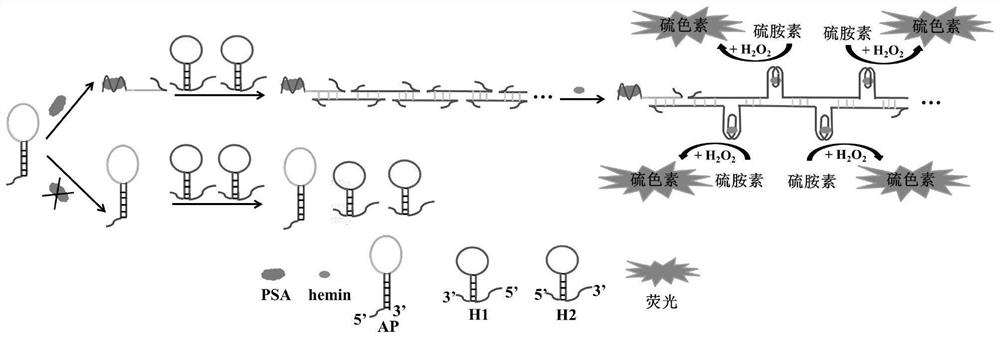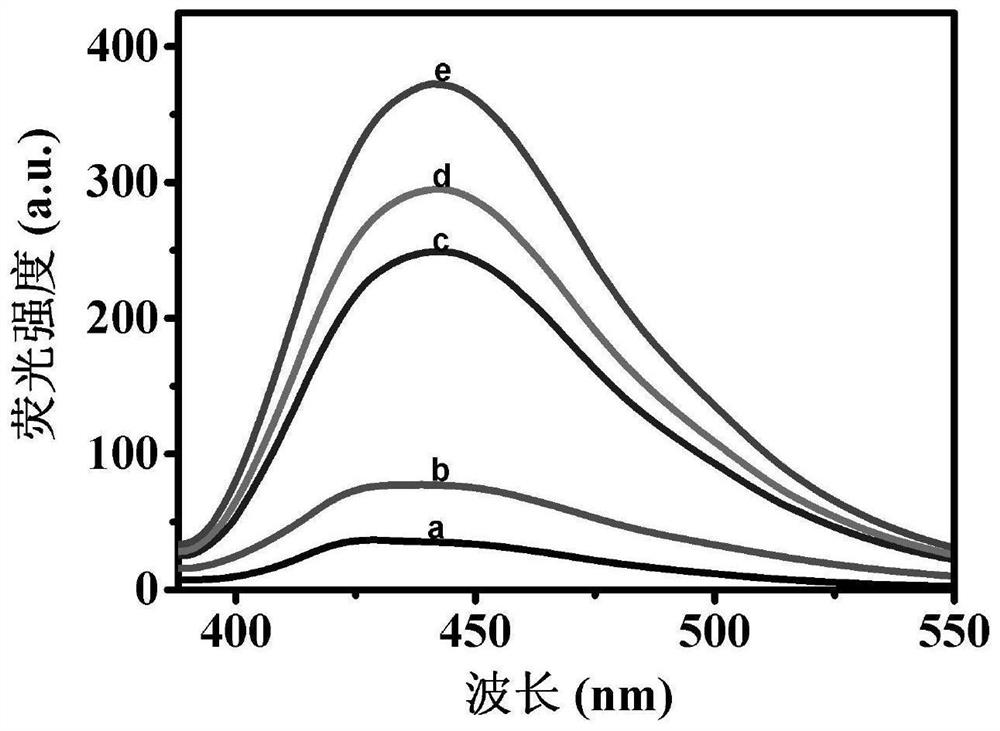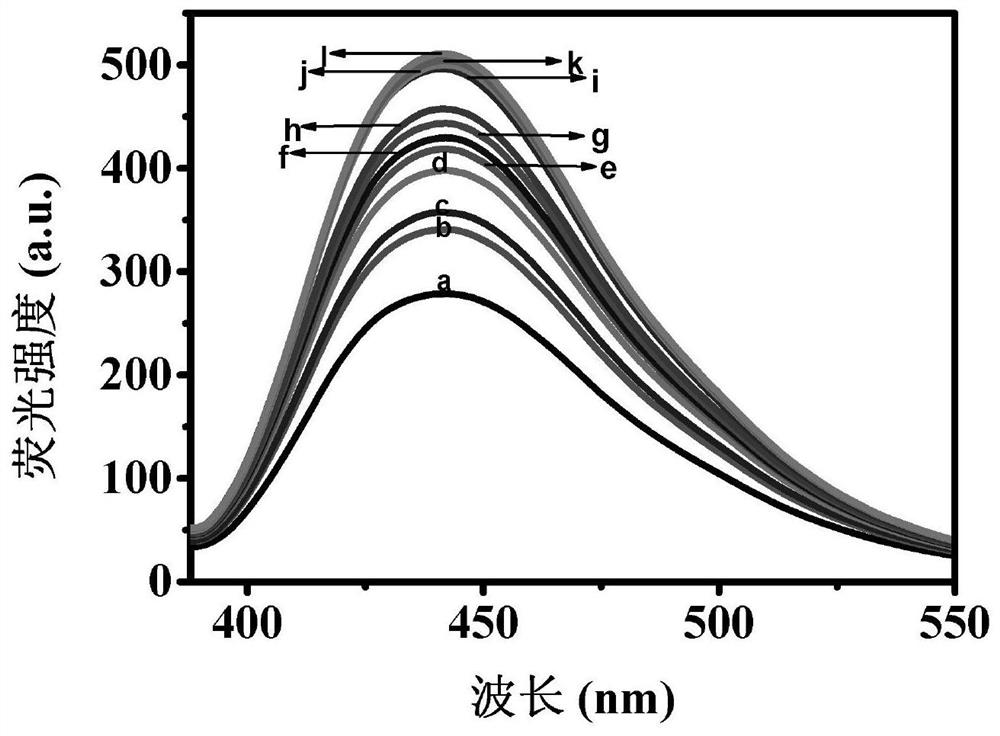Fluorescent aptamer sensor based on hybridization chain reaction and ribozyme and application of fluorescent aptamer sensor
A hybrid chain reaction and aptamer sensor technology, applied in the field of chemical and biological sensing, can solve the problems of harsh experimental conditions, poor selectivity, and low sensitivity, so as to improve selectivity and sensitivity, realize quantitative detection, and shorten detection time. the effect of time
- Summary
- Abstract
- Description
- Claims
- Application Information
AI Technical Summary
Problems solved by technology
Method used
Image
Examples
Embodiment 1
[0056] The nucleic acid aptamer probe, the first hairpin probe and the second hairpin probe were centrifuged at 10,000 rpm and 4°C for 30 seconds before opening the cover for the first time, and were dissolved in secondary water to make a concentration of 100 μM. Mother solution, then diluted with Tris-HCl buffer solution to form nucleic acid aptamer probe solution, first hairpin probe solution and second hairpin probe solution, stored at 4°C for later use; nucleic acid aptamer probe solution 5 μM 1. The first hairpin probe solution 5 μM and the second hairpin probe solution 5 μM were respectively heated to 95° C., reacted for 10 minutes, and cooled to room temperature for use.
[0057] Among them, in figure 2 In (a), add Tris-HCl buffer solution with a pH of 7.4 to the centrifuge tube, and react at 37°C for 6 hours; 2 HPO 4 -NaOH buffer, react at room temperature for 25 minutes.
[0058] exist figure 2 In (b), Tris-HCl buffer solution with a pH of 7.4 was added to the c...
Embodiment 2
[0064] The nucleic acid aptamer probe, the first hairpin probe and the second hairpin probe were centrifuged at 10,000 rpm and 4°C for 30 seconds before opening the cover for the first time, and then dissolved in secondary water to make a 100 μM mother solution, and then Dilute with Tris-HCl buffer and store at 4°C until use; heat the aptamer probe solution 5 μM, the first hairpin probe solution 5 μM and the second hairpin probe solution 5 μM to 95°C and react for 10 minutes , and cool to room temperature.
[0065] Among them, in image 3 In (a), add 50nM nucleic acid aptamer probe solution, 50nM first hairpin probe solution and 50nM second hairpin probe solution to the centrifuge tube in Tris-HCl buffer solution with pH 7.4, and react at 37°C 6 hours to obtain a mixed solution; then add 0.5 μM hemin, react at room temperature for 2 hours to obtain a reaction solution; then take out 100 μL of the reaction solution and add 5 mM thiamine solution and 25 mM hydrogen peroxide sol...
Embodiment 3
[0080] The nucleic acid aptamer probe, the first hairpin probe and the second hairpin probe were centrifuged at 10,000 rpm and 4°C for 30 seconds before opening the cover for the first time, and then dissolved in secondary water to make a 100 μM mother solution, and then Dilute with Tris-HCl buffer and store at 4°C until use; heat the aptamer probe solution 5 μM, the first hairpin probe solution 5 μM and the second hairpin probe solution 5 μM to 95°C and react for 10 minutes , and cool to room temperature.
[0081] exist Figure 5 In (a), add 50nM nucleic acid aptamer probe solution, 50nM first hairpin probe solution, 50nM second hairpin probe solution and 0.1nM immunoglobulin G (IgG) to the centrifuge tube at pH 7.4 In Tris-HCl buffer solution, react at 37°C for 6 hours to obtain a mixed solution; then add 0.5 μM hemin, react at room temperature for 2 hours to obtain a reaction solution; then take out 100 μL of the reaction solution and add 5 mM thiamine solution and 25 mM h...
PUM
 Login to View More
Login to View More Abstract
Description
Claims
Application Information
 Login to View More
Login to View More - R&D
- Intellectual Property
- Life Sciences
- Materials
- Tech Scout
- Unparalleled Data Quality
- Higher Quality Content
- 60% Fewer Hallucinations
Browse by: Latest US Patents, China's latest patents, Technical Efficacy Thesaurus, Application Domain, Technology Topic, Popular Technical Reports.
© 2025 PatSnap. All rights reserved.Legal|Privacy policy|Modern Slavery Act Transparency Statement|Sitemap|About US| Contact US: help@patsnap.com



